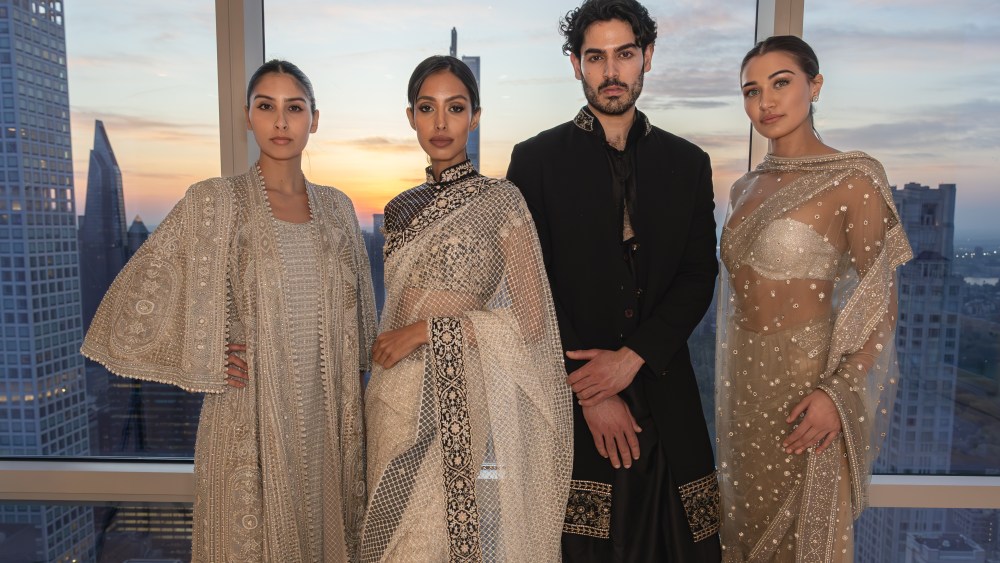Sparing attendees the wear-and-tear of a 14-hour flight from New York to New Delhi, the Indian fashion designer Tarun Tahiliani offered 100 guests a close-up view of his creations in New York City Thursday night.
The special presentation included live models, a slide show about the history of Indian fashion and insights from the designer. The crowd in the Midtown penthouse sipped vibrantly colored cocktails and some took in the sweeping view of the neighboring skyscrapers and the coral-colored setting sun.
Bibhu Mohapatra, Navina Haidar, Indira Nooyi, Shalini Misra, Ashok Mathai, Preetha Nooyi, Susan Gutfreund, Libby Rothschild, Malini Murjani, Maya Rana Tufoe and Fern Mallis were among the guests of the evening’s hostess Shalini Misra, an internationally known interior architect and designer.
While many associate India with its bold colors, Tahiliani highlighted the artistry of Indian drape — with nine yards of fabric being routine for select garments. “For me, while the color is beautiful and the embroidery is beautiful, that drape form is being lost. That is what we want to bring forward in what we call ‘the structured drape,’” he said.
You May Also Like
The garment’s elaborate embroidery and opulence prompted many to look more closely as models passed by, or to touch the styles at the designer’s encouragement. Tahiliani also referenced the book “Tarun Tahiliani: Journey to India Modern” that was published in 2023.
The Bombay-born designer, a Wharton School of Business graduate, first opened a multibrand store in 1987 with his wife, Sailaja, and has since expanded into bridal, menswear, accessories and couture. (He first saw her as an economics student modeling on the runway for Pierre Cardin.) Years later, Tahiliani attended and graduated from the Fashion Institute of Technology. He staged his first runway show in 1994 at the Dorchester Hotel in London. A year later he started his signature design studio with a team of 10.
His designs include a woven textile lehenga with a signature “TT” embroidered hip yoke, paired with a pearl and sequin-embroidered blouse. The design has a tulle drape with matching borders and tassels. He repeatedly noted how his heritage and Indian craftsmanship have influenced his ethos, but he interprets finery in a more modern way. Slides of Kim Kardashian and Lady Gaga wearing his creations were shown to illustrate that point.

The designer has drawn from Chikankari embroidery, Benares brocades, Greek-inspired drapes from the Gupta period and Pichwai art that originated 400 years ago in Nathdwara, Rajasthan. Guests also got a glimpse of the embroidered walls that he has overseen, and one guest acknowledged that she has one in her home in Geneva. Attendees also saw slides of embroidered canopies that were used for extravagant weddings.
Like some Western studios, he said his creations start with a sketch and a fit model comes in twice a week so that everything is fitted on the body. “We need to know that you can walk and sit [comfortably]. It’s not just about technique. Luxury has to be what you feel and what feels [nice] on the skin,” Tahiliani said.
But Tahiliani also spoke of how the COVID-19 pandemic changed his view. After learning that people were starving outside of one of his factories in March 2020, he took action to feed them and helped 2,000 people, despite India being in an extreme lockdown. That and other examples of pandemic-induced human suffering made Tahiliani reconsider some things. Post-pandemic the company introduced a less-extravagant brand under the umbrella of Tarun Tahiliani that is called OTT. The assortment of India-inspired modern separates has proven to be popular, despite the fact that “everyone said, ‘It will never work,’” the designer said. “It’s our highest selling collection.”
He added, “Listen to your voice. You don’t have to listen to what everyone else thinks of you. That is the freedom, courage and wisdom that you get after being in something for so long. Being forced to stop — literally stop — gives you time to think.”
Afterward, Mohapatra, the Indian-born New York-based fashion designer, said that Tahiliani is one of the reasons that he dreamed of being a designer as a child. “Now he is my friend. Tarun is the purist and the learned man. Every time he puts pen to paper, there is a history behind it. The line doesn’t form just because it is. There is a reason,” Mohapatra said.



